Makar Sankranti
Every year Makar Sankranti is celebrated in the month of January to mark the winter solstice.
It is also one of the largely celebrated Hindu festivals of India and Nepal which is celebrated differently in various cultures but the common practice on the day of Makar Sankranti is flying colourful kites.This festival is dedicated to the Hindu religious sun god Surya.
This significance of Surya is traceable to the Vedic texts, particularly the Gayatri Mantra, a sacred hymn of Hinduism found in its scripture named the Rigveda. Makara Sankranti is regarded as important for spiritual practices and accordingly, people take a holy dip in rivers, especially Ganga, Yamuna, Godavari, Krishna and Kaveri.

The bathing is believed to result in merit or absolution of past sins. They also pray to the sun and thank for their successes and prosperity.
A shared cultural practices found amongst Hindus of Nepal and various parts of India is making sticky, bound sweets particularly from sesame (til) and a sugar base such as jaggery (gud, gur, also Chaku in Nepali language).
This type of sweet is a symbolism for being together in peace and joyfulness, despite the uniqueness and differences between individuals.
For most parts of India, this period is a part of early stages of the Rabi crop and agricultural cycle, where crops have been sown and the hard work in the fields is mostly over.
The time thus signifies a period of socializing and families enjoying each other's company, taking care of the cattle, and celebrating around bonfires, in Maharashtra the festival is celebrated by flying kites.
Makar sankranti is one of the important festivals in Hindu culture which is dedicated to Lord Sun. On this auspicious day, the Sun starts its northward, or uttarayan movement or moves towards the northern hemisphere. ... From Makar sankranti, days become longer and nights shorter, and it marks the end of the winter.